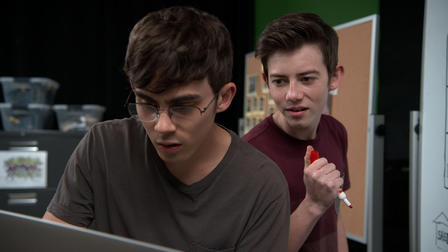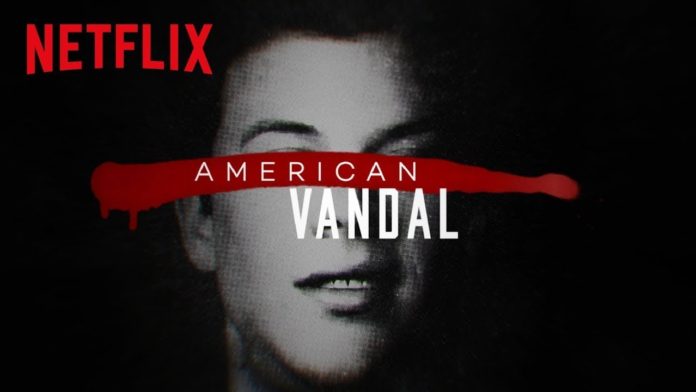One rule that I’ve always had for myself is that I’ll watch anything just to see whether or not it has any sort of value. I’ve seen film after film and show after show that were just as bad in execution as their premises seemed to suggest.
Yet every once in a while, a movie or TV show will truly surprise me with how good it actually is. Netflix’s “American Vandal” was that TV show.
Now what’s important to note about “American Vandal” is that the premise of the show will most likely turn off most people. I know that for me I thought it was childish and that there was really no intrinsic value in a mockumentary focusing on a mystery where someone spray painted 27 penises on cars. Yes, you read that correctly, the show is about spray-painted penises.
Or at least that’s what you think it’s going to be about until you realize a few episodes in that “American Vandal” is really an examination of many facets of our society. It explores our fascination with true-crime shows and investigative journalism. Most importantly, “American Vandal” is really interested in showing us how we as communities play a part in drawing false conclusions about other members of our community and the harm that action creates.
So to summarize, “American Vandal” is a satirical mockumentary, stylized much like “Making a Murderer,” “The Jinx” and “Serial,” that seeks to find the truth concerning a prank where 27 penises are spray painted onto the faculty’s vehicles at an Oceanside, Calif., high school.
Dylan Maxwell (Jimmy Tatro), a noted prankster and overall menace at the Oceanside high school, is determined to be the culprit and subsequently expelled from the school.

The duo of Peter Maldonado (Tyler Alvarez) and Sam Ecklund (Griffin Gluck), also students at the high school, decide to create a documentary that seeks to find the real perpetrator of the crime because Dylan claims to be innocent. What follows is a sometimes funny but genuine story about a team of filmmakers searching for who really “did the dicks.”
Now I feel it’s important to underscore that this show has a premise that seems wildly juvenile. Spray-painted penises as the central plot point for a show sounds like something straight out of the minds of an immature high school student, but that is kind of the point. What “American Vandal” is really interested in is setting a tone that feels authentic and realistic for immature kids on the verge of adulthood.
What this show gets right is how high school feels. It may feel foreign for much older audiences, but as someone who was in high school within the last 10 years, a lot of the interplay between the students and the general feel of what it’s like to be in high school were flawlessly reproduced.
Some aspects have been updated for the current times, but it still felt insanely familiar to me. Spray-painted penises as a school prank is most definitely something that could have happened as a real prank back when I was in high school, and in fact it did.
All of that is said to point out that this show wants to create an immersive experience that feels authentic and not be overly concerned with whether or not that premise is immature, because high schoolers are — shockingly! — fairly immature. It’s in what they do with that storyline that “American Vandal” becomes almost irresistible.
Through the process of the “documentary,” Peter and Sam note that Dylan is not a good person, and in fact he makes sense as the primary suspect for the vandalism, but towards the end of the show it becomes fairly apparent that the production team behind “American Vandal” want us to really evaluate how it is we come to that conclusion.
The show plays with the human mind a bit, as humans are organizational creatures. When we are given surface-level information that fits a narrative, we immediately draw a conclusion without really investigating further. Dylan is representative of this as he has committed similar but far less severe actions like this before, and therefore we the audience as well as the characters within the show assume Dylan is guilty without really investigating whether or not he actually is.

“American Vandal” is really good at replicating the feel of shows like “Making a Murderer” and “The Jinx.” While the story in this show is fictional, the approach to it was treated as if it were a real documentary. Every second of this show feels like a documentary. From the 3D renderings to the interview styles and cinematography, “American Vandal” does a fantastic job aping the aesthetic and construction of investigative documentaries.
What it also does really well is lampooning and critiquing the format. The deeper motive buried within “American Vandal” is to criticize the public’s fascination with investigative documentaries. The creators of the show know that people really like “Serial” and “Making a Murderer,” but they point out the flaws in those shows as well, mainly that the teams behind those shows have a vested interest in how the story plays out.
A big focus of the show is detailing how Peter becomes so engrossed in his documentary that he includes information not germane to the central focus of the documentary. That is, some information included is more about sensationalism rather than actually helping confirm or refute the idea that Dylan spray painted the penises.
We see this with “Making A Murderer,” especially where the creators weave a really compelling story, but if looked at critically a lot of the information included in the show really doesn’t help prove whether or not Steven Avery is innocent. The documentary focuses a lot on circumstantial evidence and false conclusions that have the effect of making the viewers believe Avery is unequivocally innocent rather than presenting a case where there might only be just a bit of doubt.

That sort of structure makes for a much more interesting story, and thus generates much more interest but it does have an impact as audiences of “Making A Murderer” heavily pushed for Steven Avery’s release from prison by way of social media campaigns and online petitions. “American Vandal” wants us to be made aware of the bias documentarians have and the effects that bias can create.
The premise of the spray-painted penises is really just a vehicle to inject some humor into the show, but toward the back half of the season the show becomes less funny. That is intentional because much of the critique of the investigative documentary takes place within the last 4 episodes.
The show shifts from just how ridiculous the prank is to the real implications that the prank has for Dylan. The show does a fantastic job replicating how a family would react if their son was accused of this crime and how a school would respond.
Ultimately, you may not want to watch “American Vandal.” Again, the premise for the show is really difficult for most people to buy into, and it takes an episode or two before the real intentions of the narrative become apparent. If you are someone who loves “Making a Murderer” or “Serial,” I would highly recommend this show just so you can get an idea of how those shows operate and influence their audience.
“American Vandal” is very much about digging deeper than the surface level. The use of its plot device is intentional, as I’m certain most people will brush it off based solely on its premise, but for those willing to jump in for the ride, it’s a funny, smart and nuanced look into society and the documentarians that cover it.
I give Netflix’s “American Vandal” 8.5 / 10.

















